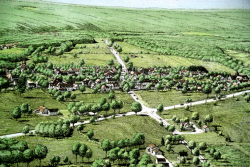Mansfield Training School
| Mansfield Training School | |
|---|---|
 Mansfield Training School | |
| Established | 1909/1917 |
| Opened | 1917 (merged) |
| Closed | 1993 |
| Current Status | Closed |
| Building Style | Cottage Plan |
| Peak Patient Population | 1,870 |
| Alternate Names |
|
This history of Mansfield Training School is very similar to other institutions of its type. It originally started out as two separate institutions.
History
The Mansfield Training School was established in 1917 with the merging of two institutions, the Connecticut Colony for Epileptics and the Connecticut Training School for the Feeble Minded (previously known as the School for Imbeciles) "to provide for the care, custody, education and employment of mental defective (feeble minded) and epileptic persons." On its opening on July 1, 1917 there were 402 students in residence.
The population and campus steadily expanded for the next fifteen years. By 1932, there were 1,070 residents, 559 males, 511 females. However, the next decade was a trying time as the depression and World War II affected Mansfield Training School. Even as the institution reached and maintained its projected maximum population, the waiting list for entry increased to over a thousand prospective people, prompting the state to open Southbury Training School in the 1940s. Cuts in the operating budget, no construction on urgently needed buildings, the lack of adequate maintenance on contemporary equipment and buildings and insufficient staff strained the quality of the services.
The next few decades following the war were marked by changes at the school. The 1950s saw an increase in construction, which included the Longley School and four new dormitories with 152 beds each. However, chronic overcrowding continued to be a problem. The number of residents and the types of education and training increased. Residents worked in the print, wood working, weaving, and industrial shops. As the number of people who worked outside of the school increased they were also provided with more realistic job training.
A change in the attitude towards the mentally challenged became increasingly evident in the 1960s. There was an increase of the ratio of the number of staff to residents. In 1969 there were 1,609 residents and 875 full time staff. The size of the campus reached 1,000 acres and had 85 buildings. The administration sought to lessen the institutional aspects of life at the school and increase activity in things like the Special Olympics. The objective of the school also reflected this change, ". to rehabilitate as many retarded persons as possible so that they can return to the community as self-supporting citizens and . to assist other retarded persons …who do not have the capacity to return to the community, to become as happy and self sufficient as possible." However, the staff was always challenged to provide quality care for such a large number of residents.
The next two decades continued the trend towards a less institutionalized attitude concerning the care and services for the mentally challenged. Cottages were created on campus and more people moved into group homes located in communities around the state. In 1976 the number of residents had dropped to 1,106. The facilities were old and the quality of care was questioned by family members of residents in a 1978 lawsuit, CARC v. Thorne that would eventually result in the closing of the school in 1993. However, the number of residents had been dropping steadily for years. Since 1984, an average of 80 men and women left the school each year. By 1991 there were 141 residents remaining. In 1993 the last buildings were closed as the last residents left for other accommodations. Some buildings were so dilapidated by this time that they were knocked down, other buildings were transferred to the use of other institutions such as the University of Connecticut and still others were abandoned.
Images of Mansfield Training School
Main Image Gallery: Mansfield Training School



